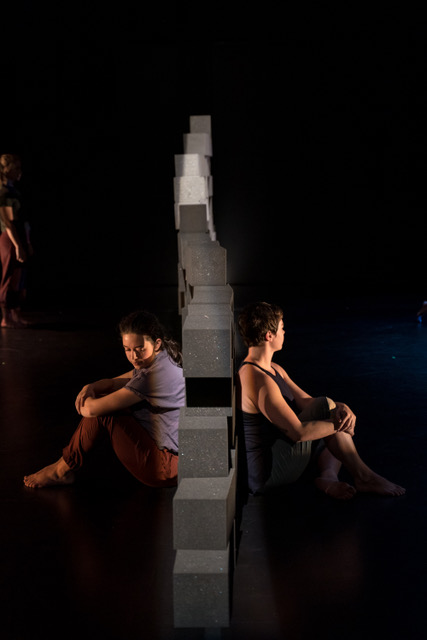
After meaning to go for several years, I finally saw a performance by the contemporary dance group Catapult Dance Company last month. They’ve been around for five years, and I’ve been meaning to go see them for almost as long. The piece was called Homeland, and I saw it 24 hours after seeing Carmina Burana at Pacific Northwest Ballet. The contrast kind of messed with my head. But in a good way.
Catapult Dance
Catapult Dance is a nonprofit contemporary dance company in Seattle headed by Michele Miller (who is also my daughters’ martial arts teacher). They are a small company, both in number and in output, producing only one or two new works each year. According their web page, all the work is a combination of choreography by Miller and improvisation by the dancers. Their technique is described as an amalgamation of forms that includes modern dance, contact improvisation, martial arts, and physical theater. Kate Olson develops a score for each new piece as it is being developed. Looking back through their history, all the dances address topical social issues.
Homeland
Homeland, as you can probably guess, relates to human migration; the walls we build to keep people in or out; and whether those walls contribute to our feelings of safety or fear. Compared to the dance I’m used to, Homeland was so literal. I mean, even the old story ballets have like a code of pantomime movements that stand for actions. Throughout the hour-ish long piece, the dancers built and destroyed walls, hid behind them and struggled to get over or through them. A couple crossed the Sonoran Desert alone, and one of them doesn’t make it. (Don’t ask me how they made a black box theater be the desert. Something about the lighting, maybe, but it was obvious.) A detainee pounds on doors (there were actually doors in the wall – we didn’t have to imagine those) looking for escape or demanding release.
New Territory
Homeland was a challenging piece for me as a viewer just because the idiom was so different from what I’m used to. This post is coming a long time after PNB’s Carmina, but that ballet was still fresh in my head when I saw Homeland. I could almost feel gears in my head trying to shift.
I know that I missed a lot of things from not knowing where to put my focus. The score zigzagged over the line between noise and music so much that I failed to recognize meaningful musical references when they came up. My friend who watches a lot more contemporary dance than I do had to point it out to me. My daughters noticed a lot of movements from kung fu that I didn’t pick up on, even thought I had been told to look for them.

The most obvious differences between ballet and contemporary dance is pointe work. But even a lot of my favorite ballets are barefoot, so that doesn’t bother me. But one thing about contemporary that I have a hard time with is all the walking around. I’ve noticed it at Kaleidoscope performances, and at SIDF earlier this year (that sums up all of my exposure to contemporary dance). Homeland, with its focus on migration, had even more walking around, and honestly, it tested my patience.
But then every time I started to tune out or wonder if these dancers just needed to catch their breath more often than ballerinas, something big would happen and I’d almost miss it. There would be something kind of like a lift except in a shape I’d never imagined before. Or I’d think, “Wait, did that person literally just climb a wall?” I appreciate the classical structures underlying ballet, but my favorite moments are when I see completely new movements, and Homeland offered up a lot of them.
Souvenirs from a New Territory
It was humbling to realize that even with such straightforward stories, I had to work at Homeland. As a ballet fan, I can get a little smug about the people who prefer tutu ballets or only want to watch dances created before 1950 (especially because they usually forget the really innovative things that happened in the first half of the 20th century – Limón anyone?). Smug and complacent are really close neighbors, the kind who like to build walls.
I am not the kind who likes to build walls, so in one sense, Homeland was preaching to the choir. (Not that it was actually preaching, because as a teacher once told me, “Art asks questions.”)

Homeland focused a lot on the suffering of those who must replace one homeland for another, but the dancers frenetically stacking blocks and cowering behind them weren’t showing much joy either. But not all walls are literal. Habits of the mind can be confining, too, and one of the most significant reasons for attending performances is to break down the walls you didn’t know you were building.




About the author